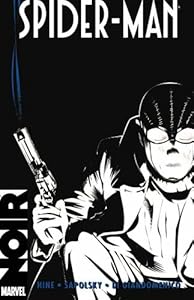Spider-Man Noir Vol.1
 |
| He swung into my office like a cool breeze on a hot day... |
Writers: David
Hine and Fabrice Sapolsky
Artist: Carmine
Di Giandomencio
Owned digitally as separate issues.
Background
Information:
One of the strengths that comic books have is that they are
constantly being re-imagined. Rather than remain stagnant, comics constantly
change their universes in order to keep the ideas fresh. It’s mostly the reason
we still read Batman, or Iron Man (whose suit was originally
all-gold and significantly uglier than current versions).
In this tradition, we have the “alternate universe” approach
to renewing franchises. This is the kind of approach that continuously asks
“What if...?” What if the X-Men lived in 2099? What if the Transformers came to
earth in the late 1800s? What if Batman lived in a dystopian universe where
everyone was made or recycled rubber ducks (okay, that one’s not actually a
story, but you get the point)?
Which leads us to the Marvel
Noir series- an attempt to re-brand certain Marvel characters in a film
noir/pulp fiction style universe set in the 1930s. These have generally been
hit-or-miss stories, with the universe’s version of X-Men garnering a lot more
critical praise than the like of, say Daredevil.
Spider-man’s Noir
treatment though, has so far received the most mainstream media attention with
the release of Spiderman: Shattered
Dimensions. The game saw a black-suited, goggle-eyed Spidey use stealth
tactics to take down gangster (not gangsta, there’s a difference) versions of
the Green Goblin, Hammerhead, and the Vulture.
Review:
If you pick up Spider-Man
Noir expecting it to remain faithful to its video game counterpart, you’re
gonna have a bad time. It’s a good read, but don’t expect to see a whole lot of
stealth action. Rather, the charm of the book lies in drawing you into this
glamorous, yet edgy world that time forgot when your great-grandparents died.
For a good half of the book, Spider-Man Noir follows not Peter Parker, but Ben Ulrich as he
struggles with his inner demons. The year is 1933 and things are bad in New
York. It’s the height of the Great Depression, out of work families are setting
up shanty towns all over the city, and people have generally lost hope. That
spells money for the Daily Bugle, so
Ulrich is sent in as a photographer to capture the suffering of Americans
wherever he can find them. While doing so, he befriends Peter and May Parker;
socialist revolutionaries who are campaigning for a better share for New York’s
down-and-outers. Ben takes a liking to Peter and immediately takes him in as an
assistant.
Don’t worry, the book is still about Spiderman, and the
focus does shift eventually to Peter and his web-slinging exploits, but writers
Hine and Sapolsky allow you to get to know him as Ben comes to know him.
Peter’s an idealistic young man who is shocked and angered by the level of
depravity all around him. The Goblin and his cronies rule most of New York,
killing anyone who doesn’t dance to their tune and that angers Peter. It serves
as a nice contrast to Ben Ulrich, who finds himself way too caught-up in this
world and actually serves as the catalyst for Ulrich to finally fight the
powers that be (however unsuccessfully).
Critics have been eager to point out that the elements of a
“noir” story aren’t really in this book. And that’s been the book’s biggest
criticism: it’s called noir, yet it’s not noir. Well, they’re right: there’s no
femme fatales, no final, conflicted hero (Ben Ulrich dies, leaving Peter as the
hero of the story) and no more urban modernity that you see in other comics.
In other news, Batman isn’t really a bat, Iron Man is
actually pretty fleshy under that armour and the Transformers don’t convert
electrical power. Okay, I’m ranting a bit now, but to judge a good story based
solely on how it reflects its name seems a little silly to me. Let’s be clear:
this book is called Spider-Man Noir
because Spider-Man in the Great
Depression Wearing Black and Fighting Gangsters is an awful title for a
book.
And it doesn’t really matter that this isn’t a noir story,
because the world absolutely sucks you in. You see classic villains re-imagined
as gangsters, circus freaks, and even cannibals. You get hooked on the social
order prevailing in New York. It all results in this great feeling of nostalgia
for a time that for all its problems, was definitely very classy.
And the art helps drive that home. Di Giandomencio does a
great job at bringing the streets and liquor houses of the early 1930s to life.
And the characters themselves have a equal sense of class and roughness. The
1930s Spider-Man looks particularly impressive. He actually looks fearsome
here; sporting black webs and even a pistol for a short time.
My only criticism of the book is really the half where the
narration shifts to Parker’s point of view. For half of the book, we see him
only as a support-character, yet when Hine and Sapolsky make him the narrator,
they seem to expect that we’ve been listening to his internal monologue all
along. We haven’t and when I read the second half I found myself thinking “who
is this guy and why should I care?” He really was far more effective as a
non-narrating character and it’s a pity that his effectiveness wares off once
we start following him more closely.
Spider-Man Noir
gives readers an intoxicating world to read about and a decent story of status
quo and activism. It gets a four out of five recycled rubber ducks.
****
+ Immersive setting.
+ When Ben Ulrich narrates, the storytelling is fantastic.
- The shift to Peter Parker loses momentum.
Alternate Option: X-Men Noir
If the whole “not noir” thing bothers you, maybe this will
calm you down a bit- it’s definitely “noir” enough.

No comments:
Post a Comment